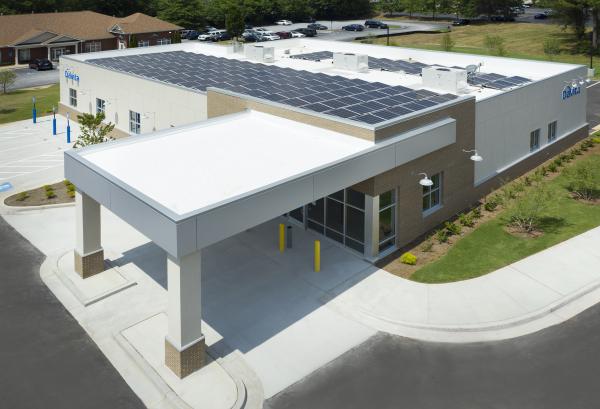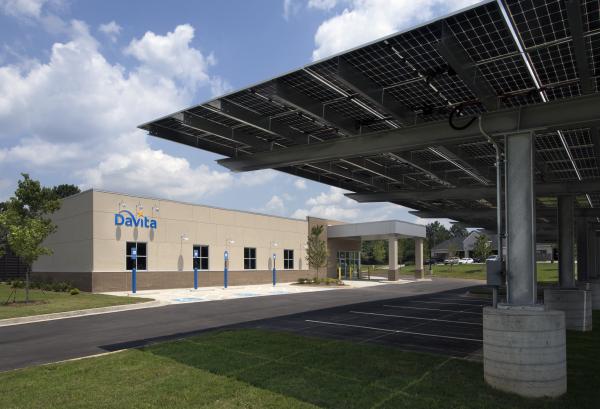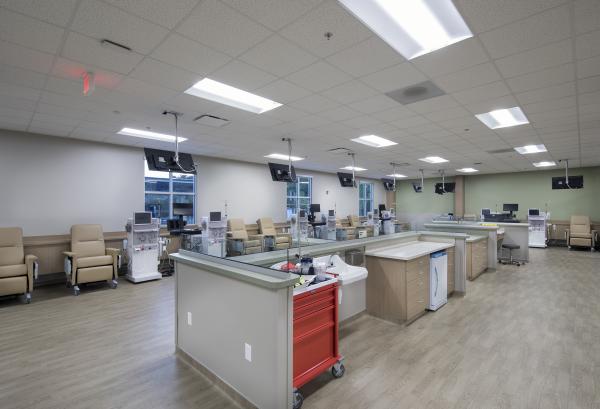DaVita has completed construction on its first planned net-zero dialysis center in Conyers, Georgia. Located about 25 miles outside of the Atlanta metropolitan area, once operational, the company believes Covington Mill will be the first net-zero dialysis center in the United States.
As a planned net-zero facility, the dialysis center will be optimally efficient, and over the course of a given year, the center expects to generate energy onsite, using clean renewable energy sources, in a quantity equal to or greater than the total amount of energy consumed onsite.
Equipped with LED lighting throughout, an automated control system for HVAC and lighting systems, as well as high efficiency water heaters and HVAC units, the Covington Mill center is expected to be considered an “all-electric” building.
Sustainability was top of mind at the earliest phases of planning this new center. DaVita's sustainability team worked with the design and construction team to design out all fossil fuel (natural gas) consumption from building operations. This involved performing energy modeling to better understand how much electricity would be required to operate the facility, and then implementing a host of energy efficient features.
For energy production, the team installed solar panels on the building’s roof—with additional solar panels installed on an adjacent carport to accommodate the amount of solar energy needed to offset expected facility operations. The carport also offers an additional benefit: covered parking to help keep patients’ cars cooler during the hot summer days in Georgia.
“We’ve been focused on our 2025 Environmental, Social and Governance (ESG) goals and we see this center as a way for DaVita to continue leveraging the latest technologies to elevate our innovative building capabilities,” DaVita’s senior director of energy and sustainability, Jeffrey Wilzbacher says.
The Covington Mill center will support in-center hemodialysis, with 17 chairs for patients to receive treatment, and will begin treating patients and generating renewable energy in April.
DaVita’s energy and sustainability team is actively evaluating the Covington Mill center to better understand how reproducible it is, as well as analyzing ways to potentially improve the design from an environmental and financial standpoint.
"This project was an effort to show how operations can grow without growing its carbon footprint. Findings from this project will give us a better understanding of the opportunities to potentially build more net-zero clinics," Wilzbacher says.
DaVita’s Commitment to Sustainability
In June 2021, DaVita achieved its goal of powering 100% of its North American operations using renewable energy.[1]This new center is another step towards achieving the kidney company’s aspirational ESG goals.
A 2020 study[2] found the U.S. health care sector is responsible for 8.5% of domestic greenhouse gas emissions. This includes health care activities and direct purchases, as well as indirect activities associated with the supply chain of health care related goods and services. This was an increase of 6% from 2010 to 2018.
DaVita has taken notice of its share of domestic and global emissions, and net-zero centers are just one option the company is exploring to help reduce its carbon footprint and work toward more sustainable operations.
The work being done in Georgia is just one part of DaVita's overall sustainability efforts, which ranges across key focus areas: energy/carbon, water, waste, buildings, supply chain and teammate engagement.
The company has previously announced several aspirational ESG goals for 2025, including goals to be 100% powered by renewable energy globally, and to reduce its carbon emissions by 50%.[3]
[1] DaVita achieved this goal, which it set in 2019, by contracting with Longroad Energy on two virtual power purchase agreements (PPAs) to construct a wind farm and a solar farm in Texas. DaVita’s share of the projects have generated as much renewable energy as the amount of electricity used by its North American Operations.
[2] Health Care Pollution And Public Health Damage In The United States: An Update; Matthew J. Eckelman, Kaixin Huang, Robert Lagasse, Emily Senay, Robert Dubrow, and Jodi D. Sherman; Health Affairs 2020 39:12, 2071-2079
[3] This article contains or refers to certain forward-looking statements within the meaning of the federal securities laws including, among other things, the Company’s ESG-related goals, such as the Company’s 2025 ESG goals, many of which are aspirational, and its corporate citizenship, diversity and belonging initiatives. Without limiting the foregoing, statements including the words “expect”, “intend”, “will”, “may”, “continue”, “target”, “goal’ and similar expressions are intended to identify forward-looking statements. The Company bases its forward-looking statements on information available to it on the date of this presentation, and undertakes no obligation to publicly update or revise any forward-looking statements, whether as a result of changed circumstances, new information, future events or otherwise, except as may otherwise be required by law. It may be difficult to achieve many of the Company’s 2025 goals during the desired timeframes or at all. Actual future events could also differ materially due to numerous factors that involve substantial known and unknown risks and uncertainties including, among other things, the risks and uncertainties set forth under “Risk Factors” and elsewhere in the Company’s reports on Form 10-K and Form 10-Q and the other risks and uncertainties discussed in any subsequent reports that the Company files with the Securities and Exchange Commission from time to time.










